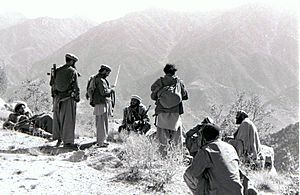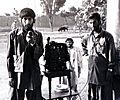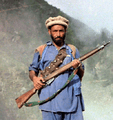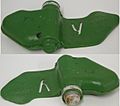Soviet war in Afghanistan facts for kids
Quick facts for kids Soviet war in Afghanistan |
|||||||
|---|---|---|---|---|---|---|---|
| Part of the conflict in Afghanistan and the Cold War | |||||||
 Mujahideen fighters in Kunar Province of Afghanistan in 1987 |
|||||||
|
|||||||
| Belligerents | |||||||
|
|
|
||||||
| Commanders and leaders | |||||||
| Strength | |||||||
|
Soviet Forces:
Afghan Forces:
|
Mujahideen: 200,000–250,000 |
||||||
| Casualties and losses | |||||||
|
Soviet Forces: 14,453 Killed (total)
53,753 Wounded 312 Missing Afghan Forces: 18,000 killed |
Mujahideen: 75,000–90,000 killed, 75,000+ wounded (tentative estimate) |
||||||
|
Civilians (Afghan): 850,000–1,500,000 killed 5 million refugees outside of Afghanistan 2 million refugees in Afghanistan Around 3 million Afghans wounded (mostly civilians) Civilians (Soviet): Around 100 dead |
|||||||
The Soviet war in Afghanistan was a long conflict that took place in Afghanistan. It started in December 1979 and ended in February 1989. This war involved the Soviet Union and the Afghan government fighting against various Afghan rebel groups. These rebel groups were known as the Mujahideen.
At first, the Afghan government struggled against the rebel groups. They asked the Soviet Union for help. When Soviet troops entered Afghanistan, more countries started supporting the rebel groups. This led to a widespread resistance movement across Afghanistan. The war became very difficult for the Soviet Union.
About 15,000 Soviet soldiers died, and around 35,000 were injured. Sadly, about one million Afghan civilians also lost their lives. The rebel forces received support from many countries. The main supporters were the United States and Pakistan.
The Soviet Union sent its 40th Army into Afghanistan starting on December 25, 1979. The fighting lasted for about ten years. Soviet troops began leaving Afghanistan on May 15, 1988. The last Soviet troops left by February 15, 1989.
Contents
Background of Afghanistan
The area that is now Afghanistan has a long history. In 731 AD, Arab people moved into this region. They brought the religion of Islam with them. After that, most people in Afghanistan became Muslim.
Afghanistan is a country with many mountains and deserts. This makes it hard to travel around. The people of Afghanistan belong to different ethnic groups. The main groups are Pashtuns, Tajiks, Hazara, Aimaks, Uzbeks, and Turkmen people.
Soviet Troops Arrive
Hafizullah Amin's Rule
In 1979, Hafizullah Amin was the leader of Afghanistan. The Soviet Union's spy agency, the KGB, believed Amin was a danger. They thought he might not be loyal to the Soviet Union. They also heard he was trying to become friends with Pakistan and China. The Soviets also suspected Amin was involved in the death of the previous president, Nur Muhammad Taraki. Because of these concerns, the Soviets decided to remove Amin from power.
Amin's Assassination
On December 22, 1979, Soviet advisors in Afghanistan took action. They cut off all phone and internet connections in Kabul, the capital city. No messages could go in or out. Soviet Air Force troops also arrived in Kabul. Amin sensed danger and moved to the Tajbeg Palace for safety.
On December 27, 1979, about 700 Soviet soldiers took control of important government buildings in Kabul. These soldiers wore uniforms that looked like the Afghan army's uniforms. At 7:00 pm, the Soviets destroyed Kabul's communication systems. This stopped Afghan troops from talking to each other.
At 7:15 pm, Soviet troops entered Tajbeg Palace. By the morning of December 28, the first part of their military action was over. Amin and his two sons were killed during the fighting. The Soviets announced that Afghanistan was now "free" from President Amin's rule. They said their soldiers were there to follow a "Treaty of Friendship" from 1978.
Babrak Karmal Becomes Leader
After Amin's death, an announcement came from Kabul radio. The Pro-Soviet Afghan Revolutionary Central Committee (ARCC) said they were responsible. Then, the ARCC chose Babrak Karmal to be the new head of Afghanistan's government. Karmal then asked the Soviet Union for military help.
Why Moscow Sent Troops
The Afghan government asked the Soviet Union many times to send soldiers. The Soviet Union had a treaty to help Afghanistan. However, they were worried about getting stuck in a long, difficult war, like the Vietnam War. So, they first suggested the Afghan government try to make peace with the rebel groups. As the situation got worse, the Soviet Union first sent only intelligence experts and advisors. But eventually, they decided to send in their army.
The War in Afghanistan
Soviet Military Actions
Soviet soldiers carried out many operations in Afghanistan. But they could never control the entire country. The Soviet soldiers were not used to fighting in Afghanistan's rough, mountainous areas. Many of them were young soldiers who had not fought in wars before. Several Afghan groups kept attacking the Soviet troops. This was a type of fighting called guerrilla warfare, where small groups use surprise attacks.
World's Reaction
Most countries around the world did not approve of the Soviet Union's actions in Afghanistan. But they admired the way the Afghan people fought back. Some reactions were very strong. U.S. President Jimmy Carter said the Soviet invasion was "the most serious threat to peace since the Second World War".
Carter threatened to boycott the 1980 Summer Olympics in Russia. He said the U.S. would not go unless the Soviet Union left Afghanistan by February 1980. The Soviets did not leave, so the U.S. and many other countries boycotted the Games.
Afghan People's Reaction
By the mid-1980s, many Afghan groups had become well-organized. They fought against the Soviet troops. These groups received help from several countries. This included the United States, United Kingdom, China, Saudi Arabia, and Pakistan.
Pakistan's Role
Pakistan believed the Soviet war in Afghanistan was also a danger to its own country. Through its intelligence agency, the ISI, Pakistan actively supported the Afghans fighting the Soviet troops.
Soviet Troops Leave
The Soviet war in Afghanistan seemed like it would never end. The Soviet Union looked bad to the rest of the world for trying to control Afghanistan. Inside the Soviet Union, most people also did not support the war. More and more Soviet soldiers were being killed or wounded. Mikhail Gorbachev, the Soviet leader, called the war a "bleeding wound." Finally, after ten years with no end in sight, the Soviets decided to leave Afghanistan.
After the War
Impact on the Soviet Union
The war in Afghanistan had a bad effect on the Soviet Union's government. Many people thought the war was against Islam. This caused strong feelings among Muslim people in the Soviet Union's Central Asian regions. The Soviet army felt very low in spirits, or "morale". They could not control the people and were seen as invaders. Andrei Sakharov, a famous Soviet scientist, openly said the Soviet army's actions were wrong.
Over 15,000 Soviet soldiers died in Afghanistan between 1979 and 1989. The Soviet Army also lost hundreds of aircraft and billions of dollars worth of military equipment. Around a million Afghan people, including men, women, and children, died in the war.
Impact on Afghanistan
Even after the Soviet Army left, a civil war continued in Afghanistan. For about three years, the Communist government of Mohammad Najibullah could not defend itself. Many groups within the government itself started supporting the Mujahideen. In March 1992, General Abdul Rashid Dostum and his forces stopped supporting Najibullah's government. Soon, Mujahideen forces took control of Kabul and began to rule most parts of Afghanistan.
During this ten-year war, Afghanistan's economy suffered greatly. Food production went down. The Soviets also tried to control businesses and industries. This also hurt the economy. When the Soviet Union broke apart into many different countries, Afghanistan's traditional trade also suffered.
Impact on the Western World
At first, many people and countries praised the USA for supporting the groups fighting the Soviet forces. But after the September 11 attacks, some people started to question the U.S. policy of supporting these groups. The U.S. has continued to be involved in Afghanistan since 2001.
Images for kids
-
Soviet ground forces in action, supported by Mi-24 helicopters and T-62 tanks, while conducting an offensive operation against the Afghan mujahideen, 1984.
-
A Mujahideen fighter in Kunar uses a communications receiver.
-
A Soviet Spetsnaz (special operations) group prepares for a mission in Afghanistan, 1988
-
U.S. President Reagan meeting with Afghan mujahideen at the White House, to highlight Soviet atrocities in Afghanistan
-
Charlie Wilson (D-TX), 2nd from the left, dressing in Afghan clothing (armed with AKS-74U) with the local Afghan mujahideen.
-
An Afghan mujahid carries a Lee–Enfield No. 4 in August 1985
-
A demonstration against the Soviet presence in Afghanistan, in The Hague, Netherlands, 1985
-
Spetsnaz troops interrogate a captured mujahideen with an RPG, rounds and AK47 in the background, 1986
-
A member of the International Committee of the Red Cross helping a wounded Afghan child walk in 1986
-
U.S. troops in 2011 surveying the Salang Pass during the War in Afghanistan, the route used by Soviet forces during the invasion 32 years before
See also
 In Spanish: Guerra de Afganistán (1978-1992) para niños
In Spanish: Guerra de Afganistán (1978-1992) para niños





































